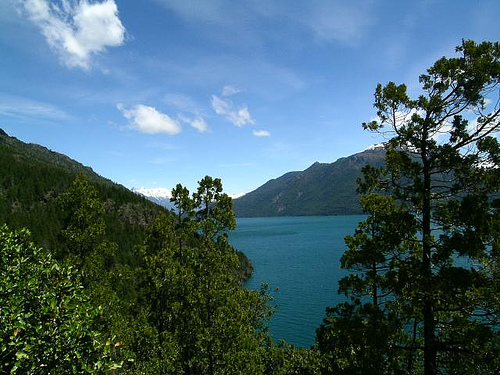

Location: Chubut Province Map
Area: 276.74 km²
Official site
Lago Puelo National Park (strictly Lago Puelo National Park and
Reserve) is located in the northwest of the province of Chubut in
Argentina. It has 27,674 ha and owes its name to the homonymous
lake. It has been part of the North Patagonian Andean Biosphere
Reserve since 2007.
The area of the Lago Puelo National
Park is subdivided into two management areas: a national park with
18,100 ha, and a protected area with managed resources with 5,600 ha
divided into two national reserves called Zona Turbio and Zona
Norte. Decree No. 2149/90 of October 10, 1990 designated 2 sectors
of the first area as a strict nature reserve.
Previous story
Decree No. 105 433 of May 11, 1937 of President Agustín Pedro Justo
declared 4 territories of Patagonia as national reserves destined
for national parks, among which was the Los Alerces National Reserve
in the National Territory of Chubut and its annex located about 115
km to the north on Lake Puelo.
Art. 2.- Set the limits of these
reserves: (...) b) For the Los Alerces National Reserve (...) As an
annex to this park, the area comprised by the southern half of lot 8
is reserved, league southwest of lot 7; lot 13; west half of lot 14;
northwest league of lot 17 and north half of lot 18, section A;
section J III of the territory of Chubut.
Decree Law No. 9504
of April 28, 1945 by Edelmiro Julián Farrell transformed the
national reserve into Los Alerces National Park, including the Puelo
Annex.
ARTICLE 7. - The Lanín, Los Alerces, Perito Francisco P.
Moreno, Los Glaciares Reserves are declared national parks, with the
limits established for the areas reserved for this purpose by Decree
105.433 of May 11, 1937, and the modifications introduced by Decrees
125, 596 of February 18, 1938, 94,284 of June 25, 1941, 118,660 of
April 30, 1942 and 129,433 of September 2, 1942.
As a rule of
a de facto government, the decree law was ratified by Law No. 13895,
sanctioned on September 30, 1949.
Geography
The relief of the park is mountainous, with lakes of
glacial origin, the most important being Lake Puelo. The rivers have a
high content of glacial sediments that give the water a turquoise and
opaque color.
Fauna
The native fauna is represented by the
huemul, the pudú, the red fox, the coypu and the puma. In the lakes
there are perch, large puyén and peladilla. The most common birds are
the flying steam duck, bandurria, Patagonian thrush, etc.
Flora
The flora is unique in the country since, thanks to the trans-Andean
connection of this valley, to the low altitude of the shores of Lake
Puelo (only about 200 meters above sea level), a particular microclimate
that this generates, the Valdivian flora has strong ingressions. These
characteristics distinguish it from the rest of the Argentine national
parks located in the Andean-Patagonian forests. The most striking
species, characteristic of the Valdivian forest, are the tique, the
hazel, the ulmo, the lingue, the deu, the white voqui, Gaultheria
insana, and the characteristic flora of a large part of the Argentine
Patagonian Andean forest: coihue, lenga, cypress of the mountain range,
radal and the arrayán.
introduced species
Among the species
introduced to the area are the rosehip, which has spread widely
throughout the area, and the trout, a species that has made other native
fish disappear.
Management
By resolution No. 126/2011 of the
National Parks Administration of May 19, 2011, it was established that
the national park would be classified for administrative purposes in the
category protected areas of complexity II, for which it is headed by a
designated intendant, On which 4 departments depend (Administration;
Works and Maintenance; National Park Rangers; Conservation and Public
Use) and 2 divisions (Entry, Exit, and Notifications Office and Desk;
Human Resources and Training). The headquarters of the administration is
located within the national park.
Information
In the park
there are areas where you can see rock art, which are reddish geometric
motifs made on stone. Groups of Mapuche settlers live to the east of the
limits of the park. Within the park there are permanent residents who
have a special permit for this purpose. The park has infrastructure to
receive visitors, you can camp, take baths, take lake walks and fish.
There are several trails to go through, of different difficulty and
duration.